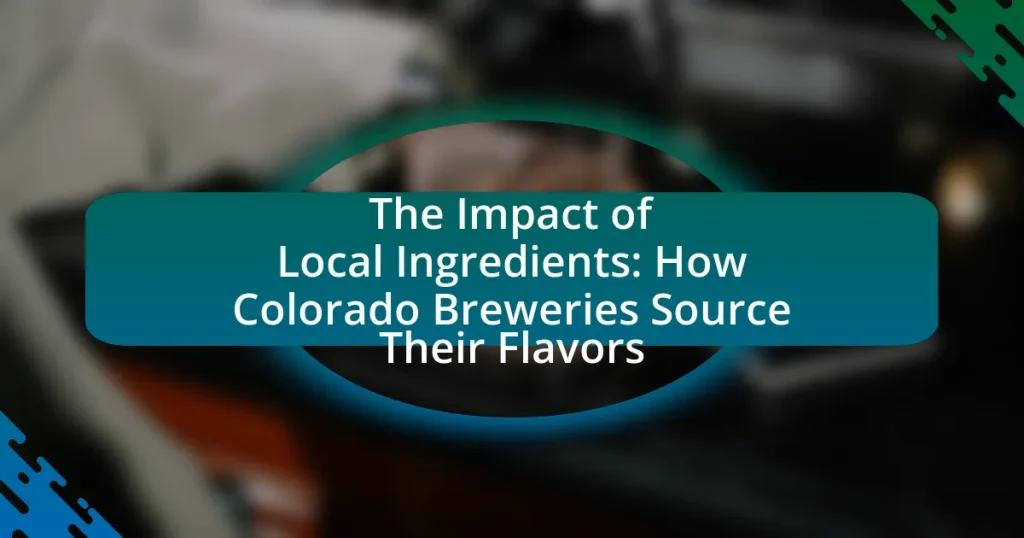The article examines the impact of local ingredients on Colorado breweries, highlighting how sourcing hops, grains, and other components from regional farms enhances the quality and uniqueness of their beers. It discusses the influence of local ingredients on flavor profiles, the economic benefits of supporting local agriculture, and the sustainability practices that arise from such sourcing. Additionally, the article addresses the challenges breweries face in obtaining local ingredients, the collaborative relationships formed with farmers, and the emerging trends in consumer preferences for locally sourced products. Overall, it underscores the significance of local sourcing in fostering a robust craft beer culture in Colorado.

What is the impact of local ingredients on Colorado breweries?
Local ingredients significantly enhance the quality and uniqueness of beers produced by Colorado breweries. By sourcing hops, grains, and other components from local farms, breweries can create distinct flavors that reflect the region’s terroir. For instance, Colorado’s diverse climate allows for the cultivation of unique hop varieties, which contribute to the aromatic profiles of local beers. Additionally, using local ingredients supports the state’s economy and fosters community relationships between breweries and farmers, as evidenced by the Colorado Brewers Guild’s initiatives promoting local sourcing. This practice not only enriches the brewing process but also strengthens the local agricultural sector, creating a sustainable ecosystem for both industries.
How do local ingredients influence the flavor profiles of Colorado beers?
Local ingredients significantly influence the flavor profiles of Colorado beers by imparting unique characteristics derived from the region’s climate, soil, and agricultural practices. For instance, Colorado’s diverse microclimates allow for the cultivation of distinct hops and barley varieties, which contribute specific aromas and tastes, such as floral, citrus, or earthy notes. Additionally, the use of local water sources, which can vary in mineral content, affects the overall mouthfeel and balance of the beer. Research indicates that breweries like New Belgium and Odell Brewing Company actively source local ingredients to enhance their products, showcasing the importance of regional sourcing in creating distinctive flavor profiles.
What specific local ingredients are commonly used by Colorado breweries?
Colorado breweries commonly use local ingredients such as barley, hops, and water sourced from the Rocky Mountains. The state’s unique climate and geography contribute to the cultivation of specific barley varieties, while local hop farms, like those in the Western Slope, provide distinct flavors. Additionally, Colorado’s pure mountain water is often cited as a key element in brewing, enhancing the overall quality of the beer. These ingredients not only reflect the local terroir but also support regional agriculture, with breweries often collaborating with local farmers to source their materials.
How do these ingredients enhance the uniqueness of Colorado beers?
Local ingredients enhance the uniqueness of Colorado beers by imparting distinct flavors and characteristics that reflect the region’s terroir. For instance, Colorado’s high-quality water, sourced from the Rocky Mountains, contributes to the crispness and clarity of the beer. Additionally, local hops varieties, such as Cascade and Centennial, provide unique aromatic profiles that are specific to the area. The use of locally grown grains, like barley, ensures freshness and supports local agriculture, further enriching the beer’s flavor. These elements combined create a signature taste that differentiates Colorado beers from those brewed elsewhere, showcasing the state’s unique brewing culture and environment.
Why is sourcing local ingredients important for Colorado breweries?
Sourcing local ingredients is important for Colorado breweries because it enhances flavor profiles and supports the local economy. By using locally sourced hops, grains, and other ingredients, breweries can create unique beers that reflect the regional terroir, which is crucial for distinguishing their products in a competitive market. Additionally, according to the Colorado Brewers Guild, local sourcing fosters community relationships and reduces transportation costs and carbon footprints, aligning with sustainability goals. This practice not only promotes freshness and quality but also strengthens the local agricultural sector, contributing to a robust craft beer culture in Colorado.
What economic benefits do local ingredients provide to breweries?
Local ingredients provide significant economic benefits to breweries by reducing transportation costs and supporting local economies. By sourcing ingredients from nearby farms and suppliers, breweries minimize shipping expenses, which can account for a substantial portion of overall production costs. Additionally, purchasing local ingredients stimulates the regional economy, creating jobs and fostering relationships with local farmers and suppliers. For instance, a study by the Brewers Association found that breweries that prioritize local sourcing contribute approximately $1.5 billion annually to local economies across the United States. This economic impact underscores the financial advantages of utilizing local ingredients in brewing operations.
How does sourcing locally contribute to sustainability in brewing?
Sourcing locally contributes to sustainability in brewing by reducing transportation emissions and supporting local economies. When breweries use ingredients from nearby farms, they minimize the carbon footprint associated with long-distance shipping, which is significant in the brewing industry. For example, a study by the Brewers Association found that local sourcing can cut transportation-related greenhouse gas emissions by up to 50%. Additionally, local sourcing fosters community relationships and encourages sustainable agricultural practices, as local farmers are often more invested in environmentally friendly methods. This creates a cycle of sustainability that benefits both the brewery and the local agricultural ecosystem.
What challenges do Colorado breweries face when sourcing local ingredients?
Colorado breweries face several challenges when sourcing local ingredients, primarily due to limited availability and seasonal fluctuations. The state’s climate can restrict the growth of certain crops, leading to inconsistent supply. For instance, barley and hops, essential for brewing, may not be produced in sufficient quantities to meet demand, especially during drought years. Additionally, local farmers may lack the infrastructure or resources to scale up production, which further complicates sourcing efforts. According to the Colorado Department of Agriculture, only about 10% of the barley used in Colorado breweries is sourced locally, highlighting the reliance on external suppliers. This situation creates challenges in maintaining quality and consistency in the brewing process.
How do seasonal variations affect the availability of local ingredients?
Seasonal variations significantly influence the availability of local ingredients by dictating the growth cycles of crops and the harvesting periods of various produce. For example, in Colorado, summer months yield a variety of fruits and vegetables, such as peaches and corn, while winter months limit availability to hardier crops like root vegetables and grains. This cyclical pattern affects breweries that rely on fresh, local ingredients for seasonal brews, as they must adapt their recipes and sourcing strategies to align with what is available at different times of the year. Consequently, breweries often emphasize seasonal flavors, utilizing ingredients that are at their peak freshness, which enhances the quality and uniqueness of their offerings.
What are the logistical challenges of sourcing local ingredients?
Sourcing local ingredients presents logistical challenges such as limited availability, inconsistent quality, and transportation issues. Limited availability arises because local farms may not produce enough quantity to meet demand, particularly during off-seasons. Inconsistent quality can occur due to variations in farming practices and environmental conditions, making it difficult for breweries to maintain a consistent flavor profile. Transportation issues include the need for timely delivery to ensure freshness, which can be complicated by geographical barriers and the lack of established supply chains. These challenges can hinder breweries’ ability to effectively utilize local ingredients in their products.

How do Colorado breweries collaborate with local farmers and suppliers?
Colorado breweries collaborate with local farmers and suppliers by sourcing ingredients such as grains, hops, and fruits directly from them, fostering a sustainable supply chain. This collaboration often includes establishing partnerships where breweries commit to using locally grown products, which not only supports the local economy but also enhances the flavor profile of their beers. For instance, many breweries participate in initiatives like the Colorado Proud program, which promotes the use of locally sourced ingredients, ensuring that a significant portion of their raw materials comes from nearby farms. This practice not only reduces transportation costs and carbon footprints but also allows breweries to create unique seasonal brews that reflect the local terroir.
What types of partnerships exist between breweries and local producers?
Breweries and local producers engage in several types of partnerships, primarily including ingredient sourcing collaborations, co-branding initiatives, and community-supported agriculture (CSA) programs. Ingredient sourcing collaborations involve breweries purchasing hops, grains, or fruits directly from local farms, enhancing the freshness and flavor profile of their beers while supporting local agriculture. Co-branding initiatives occur when breweries and local producers, such as cheese makers or bakeries, create unique products that highlight both entities, fostering a sense of community and shared identity. CSA programs allow breweries to partner with local farms to offer subscription services where customers receive seasonal ingredients, promoting local produce and creating a direct link between consumers and local agriculture. These partnerships not only benefit the breweries by improving product quality but also strengthen local economies and promote sustainable practices.
How do these partnerships benefit both breweries and farmers?
Partnerships between breweries and farmers benefit both parties by creating a sustainable supply chain that enhances product quality and local economies. Breweries gain access to fresh, locally sourced ingredients, which improves the flavor profile of their beers and strengthens their brand identity as community-focused businesses. Farmers, in turn, receive a reliable market for their crops, which can lead to increased revenue and the ability to diversify their agricultural practices. This collaboration fosters economic resilience in local communities, as evidenced by studies showing that local sourcing can increase a brewery’s sales by up to 20% while providing farmers with a stable income source.
What role do local farmers play in the brewing process?
Local farmers provide essential ingredients for the brewing process, primarily by supplying grains, hops, and other crops used in beer production. Their contributions ensure that breweries can create unique flavors that reflect the local terroir, enhancing the regional identity of the beer. For instance, Colorado breweries often source barley and hops from nearby farms, which not only supports the local economy but also promotes sustainability by reducing transportation emissions. This practice has been documented in various studies highlighting the importance of local sourcing in craft brewing, demonstrating that the use of locally grown ingredients can significantly influence the taste and quality of the final product.
How do breweries ensure quality and consistency when sourcing locally?
Breweries ensure quality and consistency when sourcing locally by establishing strong relationships with local suppliers and implementing rigorous quality control measures. These breweries often conduct thorough evaluations of local ingredients, including testing for freshness and flavor profiles, to ensure they meet specific brewing standards. Additionally, many breweries engage in regular communication with farmers and suppliers to monitor crop conditions and adjust sourcing strategies accordingly. This proactive approach helps maintain the desired taste and quality in their beers, as evidenced by the fact that breweries using locally sourced ingredients report higher customer satisfaction and brand loyalty.
What quality control measures are implemented in sourcing local ingredients?
Quality control measures in sourcing local ingredients include rigorous supplier evaluations, regular quality assessments, and adherence to safety standards. Colorado breweries often conduct site visits to inspect farms and production facilities, ensuring that ingredients meet specific quality criteria. Additionally, many breweries implement testing protocols for freshness and contamination, such as laboratory analysis for microbial presence and chemical residues. These practices are essential for maintaining the integrity of the flavors derived from local sources, ultimately enhancing the quality of the final product.
How do breweries maintain relationships with local suppliers?
Breweries maintain relationships with local suppliers through consistent communication, collaboration on product development, and mutual support in marketing efforts. By regularly engaging with suppliers, breweries ensure they are aware of ingredient availability and quality, which fosters trust and reliability. Collaborative initiatives, such as co-hosting events or creating unique brews using local ingredients, strengthen these partnerships. Additionally, breweries often promote their suppliers through branding and storytelling, highlighting the local sourcing aspect, which not only benefits the brewery’s image but also supports the supplier’s business. This symbiotic relationship is crucial for both parties, as it enhances product quality and community engagement.

What are the trends in local ingredient sourcing among Colorado breweries?
Local ingredient sourcing among Colorado breweries is increasingly focused on sustainability and community engagement. Many breweries are prioritizing the use of locally grown grains, hops, and other ingredients to reduce their carbon footprint and support local farmers. For instance, a survey by the Colorado Brewers Guild indicated that over 70% of breweries in the state are sourcing at least some of their ingredients locally, reflecting a growing trend towards farm-to-table practices in brewing. This shift not only enhances the freshness and quality of the beer but also fosters a sense of community and local identity among consumers.
How are consumer preferences shaping the use of local ingredients?
Consumer preferences are increasingly driving the use of local ingredients in Colorado breweries, as consumers show a strong inclination towards sustainability and supporting local economies. This trend is evidenced by a 2021 survey from the Brewers Association, which found that 70% of craft beer drinkers prefer breweries that use locally sourced ingredients. As a result, breweries are adapting their sourcing strategies to meet this demand, often highlighting local grains, hops, and other ingredients on their labels to attract environmentally conscious consumers. This shift not only enhances the flavor profile of the beers but also fosters community engagement and strengthens local agricultural partnerships.
What specific trends are emerging in the craft beer market regarding local sourcing?
Emerging trends in the craft beer market regarding local sourcing include an increased emphasis on using locally grown ingredients, such as hops and grains, to enhance flavor profiles and support regional agriculture. Breweries are increasingly collaborating with local farmers to ensure freshness and sustainability, which not only improves the quality of the beer but also strengthens community ties. For instance, a report from the Brewers Association indicates that 60% of craft breweries prioritize local sourcing to differentiate their products and appeal to consumers who value sustainability and local economies. This trend reflects a broader consumer preference for transparency and authenticity in food and beverage choices.
How do breweries adapt to changing consumer demands for local flavors?
Breweries adapt to changing consumer demands for local flavors by sourcing ingredients from nearby farms and producers, thereby enhancing the regional character of their beers. This practice not only supports local economies but also aligns with consumer preferences for fresh, unique, and authentic flavors. For instance, many Colorado breweries utilize locally grown hops, grains, and fruits, which allows them to create distinctive seasonal brews that reflect the local terroir. Additionally, breweries often engage with their communities through events and collaborations, further solidifying their connection to local culture and tastes. This strategy is validated by the increasing trend of craft beer consumers prioritizing local products, as evidenced by a 2022 survey indicating that 70% of craft beer drinkers prefer beers made with local ingredients.
What innovations are being introduced in the use of local ingredients?
Innovations in the use of local ingredients in Colorado breweries include the development of unique beer styles that incorporate native grains, fruits, and herbs. For instance, breweries are increasingly utilizing locally sourced grains like Colorado-grown barley and wheat to create distinct flavor profiles that reflect the region’s terroir. Additionally, some breweries are experimenting with indigenous fruits such as peaches and cherries, which are abundant in Colorado, to enhance the taste and aroma of their beers. This trend not only supports local agriculture but also fosters a sense of community and sustainability within the brewing industry.
How are breweries experimenting with new local ingredients?
Breweries are experimenting with new local ingredients by incorporating unique regional crops, herbs, and fruits into their brewing processes. For instance, Colorado breweries are utilizing locally sourced ingredients like Colorado-grown barley, hops, and even indigenous plants such as juniper berries and sage to create distinctive flavors that reflect the local terroir. This practice not only enhances the flavor profiles of their beers but also supports local agriculture and fosters community relationships. The trend is evidenced by the rise in popularity of craft beers that highlight these local ingredients, with breweries often showcasing their sourcing practices on labels and in marketing materials, thereby promoting transparency and local pride.
What role does technology play in sourcing and utilizing local ingredients?
Technology plays a crucial role in sourcing and utilizing local ingredients by enhancing efficiency and connectivity between producers and consumers. Advanced tools such as mobile apps and online platforms facilitate direct communication between breweries and local farmers, allowing for real-time updates on ingredient availability and quality. For instance, data analytics can optimize supply chain logistics, ensuring that breweries receive fresh ingredients promptly, which is essential for maintaining flavor integrity. Additionally, technologies like blockchain can provide transparency in sourcing, allowing breweries to trace the origin of their ingredients, thereby fostering trust with consumers. This integration of technology not only streamlines operations but also supports local economies by promoting sustainable practices and reducing transportation costs.
What best practices can Colorado breweries adopt for sourcing local ingredients?
Colorado breweries can adopt best practices for sourcing local ingredients by establishing partnerships with local farmers and suppliers to ensure a consistent supply of fresh, high-quality materials. Collaborating with regional agricultural organizations can help breweries identify and connect with local producers, fostering a sustainable supply chain. Additionally, implementing seasonal menus that highlight locally sourced ingredients can enhance the brewery’s offerings while supporting the local economy. Research indicates that breweries using local ingredients can improve their brand image and customer loyalty, as consumers increasingly prefer products that support local communities.
How can breweries effectively build relationships with local suppliers?
Breweries can effectively build relationships with local suppliers by prioritizing open communication and collaboration. Establishing regular meetings and discussions fosters transparency and trust, allowing breweries to understand suppliers’ capabilities and challenges. Additionally, breweries should engage in joint marketing efforts, such as featuring local ingredients in promotional materials, which not only highlights the partnership but also strengthens community ties. Research indicates that local sourcing can enhance product quality and customer loyalty, as consumers increasingly prefer locally sourced products. By actively participating in local events and supporting suppliers’ initiatives, breweries can further solidify these relationships, creating a mutually beneficial ecosystem that supports both parties.
What strategies can breweries use to promote their local ingredient sourcing to consumers?
Breweries can promote their local ingredient sourcing to consumers through strategies such as transparent labeling, community engagement, and storytelling. Transparent labeling allows breweries to clearly indicate the origin of their ingredients on packaging, which builds trust and informs consumers about local sourcing. Community engagement can involve hosting events or collaborating with local farmers, which fosters a connection between the brewery and the community, enhancing consumer loyalty. Storytelling, through marketing campaigns or social media, can highlight the journey of local ingredients from farm to glass, creating an emotional connection and emphasizing the quality and uniqueness of the product. These strategies are effective as they not only inform consumers but also create a sense of pride and support for local agriculture, which is increasingly valued in the craft beer market.


